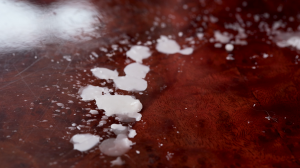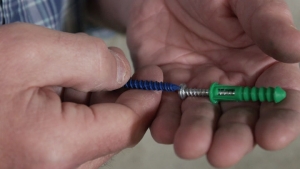How to Cut an Inspection Hole in a Wall
How to Cut an Easily Repairable Inspection Hole in a Wall
An inspection hole will allow you to see where pipes and wires are located behind the wall. A cleanly cut inspection hole can easily be patched once your work in the wall is complete, or if it turns out that you don't want to make an opening there after all.
When you have identified and marked the boundaries of your inspection hole with a pencil, cut along the lines using a drywall or wallboard saw, which has a very sharp tip. Twisting and pushing the saw allows that tip to penetrate the wallboard when you make your first cut. Hold the saw at a 45-degree angle, as in the diagram, to create a clean beveled cut.
Using smooth, even strokes, saw along one of the vertical sides. At the bottom, pull the blade most of the way out, twist it 90 degrees, and begin cutting the next side. Repeat the process on the remaining sides, making sure to maintain the bevel by keeping the saw at a 45-degree angle.
Before you cut along the final side, mark the top of the square you are cutting with an arrow inside the square, so you can orient the piece correctly later. A benefit of the bevel is that it will prevent the piece from falling into the wall when it's time to push it back into place.
Now you can peek inside the wall and see if there's anything that would prevent you from proceeding with the planned opening.
If there is something in the wall that you'd rather address later, or if you decide to make a larger opening somewhere else, no problem! To close up the hole, first apply joint compound to the sides of the opening and the edges of the piece you cut out.
When the patch is pressed into place, excess joint compound will squeeze out on the back side of the wall. When this dries, it will help to hold the piece in place.
The patch may be slightly lower than the surrounding wall. To correct this, skim a bit of compound on the face. Then remove the excess with a wider joint knife, leaving the patch flush with the wall.
Now let the compound dry, give it a little sanding, and cover it with a coat of paint.
When you're finished, nobody will know you'd ever been there . . . but you'll know that you saved yourself the trouble of dealing with larger plumbing and electrical systems by fixing them yourself, or worse -- accidentally cutting into the wrong section of the wall!
Blog Articles
Have You Heard of Landscape Glue?
You love the rustic charm of a gravel walkway, but the constant scattering of stones across your lawn and patio can be a real headache. Whether it’s from pets, lawn mowers, or just foot traffic, it seems impossible to keep those stones in place. Sound familiar? Well, Brian shows us a simple DIY method using landscape glue to keep your gravel path looking pristine and, more importantly, in place.
How to Remove Candle Wax Drips: Two Effective Methods
Candles create a warm and inviting atmosphere, but those pesky wax drips can be a real headache. Luckily, Brian shows us a couple of effective methods to tackle this issue, and they involve two very different temperatures: hot and cold. Here, we'll explore two effective methods: one using cold and the other using heat.
Guide to Hanging on Masonry Walls
Ever wondered how to hang that picture frame or shelf on a brick or concrete wall? It can seem daunting, but with the right tools and techniques, it's a straightforward DIY project. This guide breaks down two common methods: using concrete screws and using anchors, making it easy for you to tackle your next hanging project.





